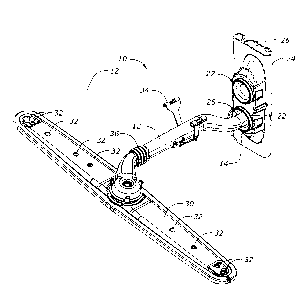Some of the information on this Web page has been provided by external sources. The Government of Canada is not responsible for the accuracy, reliability or currency of the information supplied by external sources. Users wishing to rely upon this information should consult directly with the source of the information. Content provided by external sources is not subject to official languages, privacy and accessibility requirements.
Any discrepancies in the text and image of the Claims and Abstract are due to differing posting times. Text of the Claims and Abstract are posted:
| (12) Patent Application: | (11) CA 2428672 |
|---|---|
| (54) English Title: | BULLET ENDED WASH TUBE FOR DISHWASHER |
| (54) French Title: | TUBE DE LAVAGE A EXTREMITE CONIQUE POUR LAVE-VAISSELLE |
| Status: | Deemed Abandoned and Beyond the Period of Reinstatement - Pending Response to Notice of Disregarded Communication |
| (51) International Patent Classification (IPC): |
|
|---|---|
| (72) Inventors : |
|
| (73) Owners : |
|
| (71) Applicants : |
|
| (74) Agent: | FINLAYSON & SINGLEHURST |
| (74) Associate agent: | |
| (45) Issued: | |
| (22) Filed Date: | 2003-05-13 |
| (41) Open to Public Inspection: | 2003-12-27 |
| Examination requested: | 2008-02-08 |
| Availability of licence: | N/A |
| Dedicated to the Public: | N/A |
| (25) Language of filing: | English |
| Patent Cooperation Treaty (PCT): | No |
|---|
| (30) Application Priority Data: | ||||||
|---|---|---|---|---|---|---|
|
an improved wash tube is provided for a dishwasher. The wash tube is
mounted on the upper rack and has a first end adapted to be releasably docked
with the water manifold in the back of the dishwashing chamber as the rack is
moved between the extended loading position and the retracted wash position.
The inner end of the wash tube includes a curved cap which increases the
docking
tolerance and which presents a substantially downwardly oriented water inlet
to
the wash tube. The cap creates water stagnation adjacent the inlet such that
the
water velocity is substantially reduced and the pressure increased. The second
end
of the wash tube is connected to the spray arm which rotates as water is
ejected
from the spray arm nozzles at increased pressure. The cap allows the wash tube
to
fully dock into the manifold without obstructing the water inlet.
Note: Claims are shown in the official language in which they were submitted.
Note: Descriptions are shown in the official language in which they were submitted.

2024-08-01:As part of the Next Generation Patents (NGP) transition, the Canadian Patents Database (CPD) now contains a more detailed Event History, which replicates the Event Log of our new back-office solution.
Please note that "Inactive:" events refers to events no longer in use in our new back-office solution.
For a clearer understanding of the status of the application/patent presented on this page, the site Disclaimer , as well as the definitions for Patent , Event History , Maintenance Fee and Payment History should be consulted.
| Description | Date |
|---|---|
| Application Not Reinstated by Deadline | 2010-05-13 |
| Time Limit for Reversal Expired | 2010-05-13 |
| Deemed Abandoned - Failure to Respond to Maintenance Fee Notice | 2009-05-13 |
| Letter Sent | 2008-04-14 |
| Amendment Received - Voluntary Amendment | 2008-02-22 |
| All Requirements for Examination Determined Compliant | 2008-02-08 |
| Request for Examination Requirements Determined Compliant | 2008-02-08 |
| Request for Examination Received | 2008-02-08 |
| Inactive: IPC from MCD | 2006-03-12 |
| Inactive: IPC from MCD | 2006-03-12 |
| Application Published (Open to Public Inspection) | 2003-12-27 |
| Inactive: Cover page published | 2003-12-26 |
| Inactive: First IPC assigned | 2003-07-17 |
| Application Received - Regular National | 2003-06-12 |
| Filing Requirements Determined Compliant | 2003-06-12 |
| Letter Sent | 2003-06-12 |
| Inactive: Filing certificate - No RFE (English) | 2003-06-12 |
| Abandonment Date | Reason | Reinstatement Date |
|---|---|---|
| 2009-05-13 |
The last payment was received on 2008-04-21
Note : If the full payment has not been received on or before the date indicated, a further fee may be required which may be one of the following
Please refer to the CIPO Patent Fees web page to see all current fee amounts.
| Fee Type | Anniversary Year | Due Date | Paid Date |
|---|---|---|---|
| Application fee - standard | 2003-05-13 | ||
| Registration of a document | 2003-05-13 | ||
| MF (application, 2nd anniv.) - standard | 02 | 2005-05-13 | 2005-01-20 |
| MF (application, 3rd anniv.) - standard | 03 | 2006-05-15 | 2006-01-12 |
| MF (application, 4th anniv.) - standard | 04 | 2007-05-14 | 2007-04-18 |
| Request for examination - standard | 2008-02-08 | ||
| MF (application, 5th anniv.) - standard | 05 | 2008-05-13 | 2008-04-21 |
Note: Records showing the ownership history in alphabetical order.
| Current Owners on Record |
|---|
| MAYTAG CORPORATION |
| Past Owners on Record |
|---|
| JOHN TREVOR MORRISON |
| ROBERT A. ELICK |